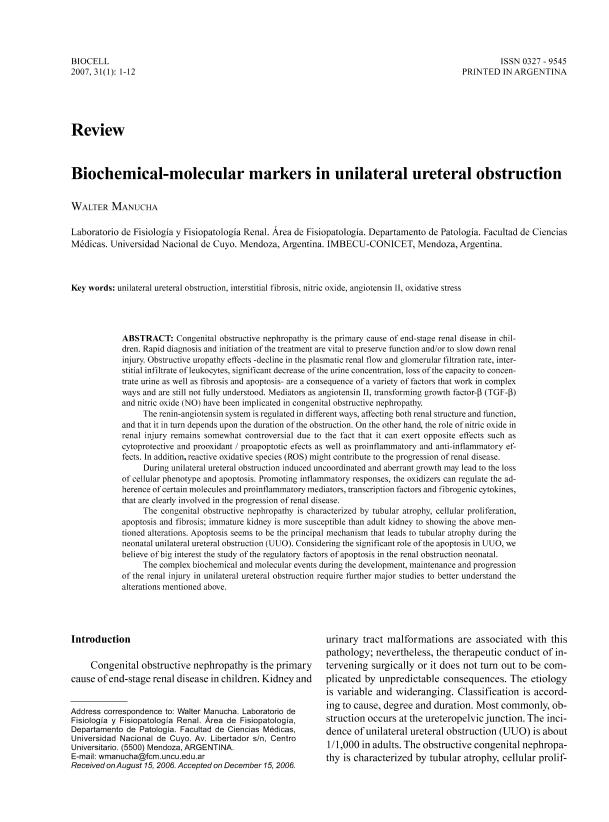Artículo
Biochemical-molecular markers in unilateral ureteral obstruction
Fecha de publicación:
12/2007
Editorial:
Instituto de Histología y Embriología
Revista:
Biocell
ISSN:
0327-9545
Idioma:
Inglés
Tipo de recurso:
Artículo publicado
Clasificación temática:
Resumen
Congenital obstructive nephropathy is the primary cause of end-stage renal disease in chil dren. Rapid diagnosis and initiation of the treatment are vital to preserve function and/or to slow down renal injury. Obstructive uropathy effects -decline in the plasmatic renal flow and glomerular filtration rate, inter stitial infiltrate of leukocytes, significant decrease of the urine concentration, loss of the capacity to concen trate urine as well as fibrosis and apoptosis- are a consequence of a variety of factors that work in complex ways and are still not fully understood. Mediators as angiotensin II, transforming growth factor-β (TGF-β) and nitric oxide (NO) have been implicated in congenital obstructive nephropathy. The renin-angiotensin system is regulated in different ways, affecting both renal structure and function, and that it in turn depends upon the duration of the obstruction. On the other hand, the role of nitric oxide in renal injury remains somewhat controversial due to the fact that it can exert opposite effects such as cytoprotective and prooxidant / proapoptotic efects as well as proinflammatory and anti-inflammatory ef fects. In addition, reactive oxidative species (ROS) might contribute to the progression of renal disease. During unilateral ureteral obstruction induced uncoordinated and aberrant growth may lead to the loss of cellular phenotype and apoptosis. Promoting inflammatory responses, the oxidizers can regulate the ad herence of certain molecules and proinflammatory mediators, transcription factors and fibrogenic cytokines, that are clearly involved in the progression of renal disease. The congenital obstructive nephropathy is characterized by tubular atrophy, cellular proliferation,apoptosis and fibrosis; immature kidney is more susceptible than adult kidney to showing the above men tioned alterations. Apoptosis seems to be the principal mechanism that leads to tubular atrophy during the neonatal unilateral ureteral obstruction (UUO). Considering the significant role of the apoptosis in UUO, we believe of big interest the study of the regulatory factors of apoptosis in the renal obstruction neonatal.The complex biochemical and molecular events during the development, maintenance and progression of the renal injury in unilateral ureteral obstruction require further major studies to better understand the alterations mentioned above.
Palabras clave:
UUO
,
APOPTOSIS
,
FIBROSIS
,
NO
Archivos asociados
Licencia
Identificadores
Colecciones
Articulos(IMBECU)
Articulos de INST. DE MEDICINA Y BIO. EXP. DE CUYO
Articulos de INST. DE MEDICINA Y BIO. EXP. DE CUYO
Citación
Manucha, Walter Ariel Fernando; Biochemical-molecular markers in unilateral ureteral obstruction; Instituto de Histología y Embriología; Biocell; 31; 1; 12-2007; 1-12
Compartir




